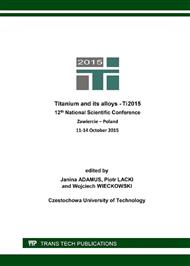[1]
M. Motyka, Thermomechanical processing for development of phase constituents morphology and plasticity of two-phase titanium alloys, RUT Publishing House, Rzeszow 2015 (in Polish).
Google Scholar
[2]
T.G. Nieh, J., Wadsworth, O.D. Sherby, Superplasticity in metals and ceramics, Cambridge Univ. Press, Cambridge, (1997).
Google Scholar
[3]
A.J. Barnes, Industrial applications of superplastic forming: Trends and prospects, Mat. Sci. Forum, 357-359 (2001) 3-16.
DOI: 10.4028/www.scientific.net/msf.357-359.3
Google Scholar
[4]
J. Sieniawski, M. Motyka, Superplasticity in titanium alloys, J. Achiev. Mat. Manuf. Eng. 24 (2007) 1 123-130.
Google Scholar
[5]
M. Motyka, J. Sieniawski, W. Ziaja, Microstructural aspects of superplasticity in Ti-6Al-4V alloy, Mat. Sci. Eng. A599 (2014) 57-63.
DOI: 10.1016/j.msea.2014.01.067
Google Scholar
[6]
H. Inagaki, Enhanced superplasticity in high strength Ti alloys, Z. Metallkd. 86 (1995) 643-650.
DOI: 10.1515/ijmr-1995-860911
Google Scholar
[7]
H. Inagaki, Mechanism of enhanced superplasticity in thermomechanically processed Ti-6Al-4V, Z. Metallkd. 87 (1996) 3 179-186.
DOI: 10.1515/ijmr-1996-870306
Google Scholar
[8]
E.B. Shell, S.L. Semiatin, Effect of initial microstructure on plastic flow and dynamic globularization during hot working of Ti-6Al-4V, Metall. Mater. Trans. A 30A (1999) 3219-3229.
DOI: 10.1007/s11661-999-0232-4
Google Scholar
[9]
T. Seshacharyulu, S.C. Medeiros, J.T. Morgan, J.C. Malas, W.G. Frazier, Y.V.R.K. Prasad, Hot deformation mechanisms in ELI grade Ti-6Al-4V, Scripta Mater. 41 (1999) 3 283-288.
DOI: 10.1016/s1359-6462(99)00163-3
Google Scholar
[10]
R. Ding, Z.X. Guo, A. Wilson A., Microstructural evolution of a Ti-6Al-4V alloy during thermomechanical processing. Mat. Sci. Eng. A327 (2002) 233-245.
DOI: 10.1016/s0921-5093(01)01531-3
Google Scholar
[11]
S.L. Semiatin, JJ. Jonas, Formability and workability of metals: Plastic instability and flow localization, ASM International, Materials Park, OH (1984).
Google Scholar
[12]
X. Ma, W. Zeng, F. Tian, Y. Zhou,: The kinetics of dynamics globularization during hot working of a two phase titanium alloy with starting lamellar microstructure, Mat. Sci. Eng. A548 (2012) 6-11.
DOI: 10.1016/j.msea.2012.03.022
Google Scholar
[13]
S.L. Semiatin, S.L. Knisley, P.N. Fagin, F. Zhang, D.R. Barker, Microstructure evolution during alpha-beta heat treatment of Ti-6Al-4V, Metall. Mater. Trans. A 34A (2003) 2377-2386.
DOI: 10.1007/s11661-003-0300-0
Google Scholar
[14]
H.W. Song, S.H. Zhang, M. Cheng, Dynamic globularization kinetics during hot working of a two phase titanium alloy with a colony alpha microstructure, J. All. Comp. 480 (2009) 922-927.
DOI: 10.1016/j.jallcom.2009.02.059
Google Scholar
[15]
M. Motyka, J. Sieniawski, W. Ziaja, G. Mrowka-Nowotnik, Microstructural characterization of quenched and plastically deformed two-phase a+b titanium alloys, Arch. Metall. Mater. (2015) – in press.
DOI: 10.1515/amm-2015-0345
Google Scholar
[16]
R.G. Guan, Y.T. Je, Z.Y. Zhao, C.S. Lee, Effect of microstructure on deformation behavior of Ti–6Al–4V alloy during compressing process, Mater. Design 36 (2012) 796–803.
DOI: 10.1016/j.matdes.2011.11.057
Google Scholar
[17]
R.M. Miller, T.R. Bieler, S.L. Semiatin, Flow softening during hot working of Ti-6Al-4V with a lamellar colony microstructure, Scripta Mater. 40 (1999) 12 1387-1393.
DOI: 10.1016/s1359-6462(99)00061-5
Google Scholar
[18]
A. Majorell, S. Srivatsa, R.C. Picu, Mechanical behavior of Ti-6Al-4V at high and moderate temperatures – Part I: Experimental Results, Mat. Sci. Eng. A326 (2002) 297-305.
DOI: 10.1016/s0921-5093(01)01507-6
Google Scholar
[19]
S. Malinov, W. Sha, Z. Guo, C.C. Tang, A.E. Long, Synchrotron X-ray diffraction study of the phase transformations in titanium alloys, Mater. Charact. 48 (2002) 279-295.
DOI: 10.1016/s1044-5803(02)00286-3
Google Scholar
[20]
H. Chen, C. Cao, L. Guo, H. Lin, Hot deformation mechanism and microstructure evolution of TC11 titanium alloy in β field. T. Nonferr. Metals Soc. 18 (2008) 1021-1027.
DOI: 10.1016/s1003-6326(08)60175-2
Google Scholar
[21]
B.D. Venkatesh, D.L. Chen, S.D. Bhole, Effect of heat treatment on mechanical properties of Ti–6Al–4V ELI alloy, Mat. Sci. Eng. A506 (2009) 117–124.
DOI: 10.1016/j.msea.2008.11.018
Google Scholar
[22]
J.H. Kim, S.L. Semiatin, C.S. Lee, Constitutive analysis of the high-temperature deformation of Ti-6Al-4V with a transformed microstructure, Acta Mater. 51 (2003) 5613-5626.
DOI: 10.1016/s1359-6454(03)00426-9
Google Scholar


